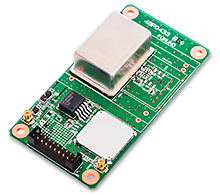Articles for ITS market Tesla's original connection to Taiwan and the new transportation system technologies.
Tesla’s early technology originated in Taiwan
 The World’s Trade Center held the EVT Taiwan show. It is next to the famous tower ”Taipei 101”.
The World’s Trade Center held the EVT Taiwan show. It is next to the famous tower ”Taipei 101”.
 Hall no.1 in the World’s Trade Center.
Hall no.1 in the World’s Trade Center.
 Work shop for EV held in EV Taiwan show.
Work shop for EV held in EV Taiwan show.
 The booth of FUKUTA the Taiwanese company that developed Tesla’s engine.
The booth of FUKUTA the Taiwanese company that developed Tesla’s engine.
Taiwan is now gathering the attention of the worldwide economic and political sectors now that the acquisition of SHARP by Hon Hai / Foxconn Technology Group was settled and the Democratic Progressive Party became the ruling party in May 2016. These changes have created new movement in the automotive markets.
In April 2016 I visited Taipei city. There are many kinds of shows during this time of the year. For example, “Taipei International Auto Parts & Accessories Show”, “Motor cycle Taiwan”, “AutoTronics Taipei”, “EV Taiwan” and so on.
The first one to attract my attention was “EV Taiwan”. Taiwan and EV (Electric Vehicle). This partnership is not well known by the Japanese automotive industry or general public but I believe many people would be interested to learn, “Tesla’s technology is originally from Taiwan”
Tesla originally manufactured their EV, “ROADSTER” which was a modified version of the Lotus “Elise”. They partnered with the EV start-up company “AC Propulsion” which provided the EV technology to Tesla in Los Angeles. AC Propulsion had a Taiwanese investor which is a main reason why Tesla purchased the EV related parts from Taiwan.
To be more specific the engines were from FUKUTA Electronics and control circuits like the inverter, etc. were from Chroma ATE. I have reviewed the history of Tesla’s founding and remember when visiting FUKUTA Electronics at Taichung city, the CEO, Mr. Chin Feng Chang said:
“First, Tesla directly visited our company with people in Ministry of Economy, Trade and Industry of Taiwan. They have already visited several engine manufacturers before coming to us, but they all refused to work with Tesla because it is very difficult for them to do the mass production of the engine Tesla required. That is why we have accepted it with the belief we would make it. It was actually a very long way to reach the implementation and we invested quite a few amounts of capital by ourselves”
Now, ten years later Tesla is expanding their product line to include the “Model S”, “Model X” and “Model 3”, etc. During this process the engine assembly, inverter and body is moving to California for the “Model S” and others because of their US government duties. Tesla acquired more than three hundred million US dollars in subsidies from United States Department of Energy. This is for the advanced and next generation vehicle development and to complete the corporate acquisition of the joint venture company of TOYOTA and GM. The previous technology gained from Taiwanese companies is now being merged into Tesla as basic EV technology.
Another technology from Taiwan that deeply influenced Tesla is a lithium ion secondary battery pack. The originator of the cylindrical battery called “the battery of computer” as well as “18650” sized 18mm and 65mm is actually AC Propulsion. Tesla was purchasing batteries from several Japanese and Korean companies and one of them was “E-One Moli”, the joint venture company composed by Taiwan and Canada. Currently Tesla is developing a contract with Panasonic as the exclusive supplier. Tesla is planning to open a new factory called “GIGA Factory” which starts operations at the end of 2016 in Nevada.
The “EV” market has not grown as expected even though the Taiwan government has tried to leverage Tesla’s experience to help grow the market.
 Taiwanese LEV (Light Electric Vehicle)
Taiwanese LEV (Light Electric Vehicle)
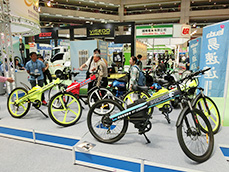 LEV’s being charging at the replaceable charging station.
LEV’s being charging at the replaceable charging station.
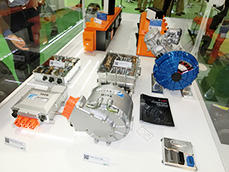 The EV and Range Extender related equipment developed by TARC and a private company.
The EV and Range Extender related equipment developed by TARC and a private company.
As mentioned above, Taiwan was the starting point of Tesla’s technology and the government has been working very hard to develop and grow the popularity of the LEV (Light Electric Vehicle) which includes the small electric motorcycle and middle electric vehicles in Taiwan.
TARC (Taiwan Automotive Research Consortium) is the core group for this work. TARC has been tasked to make the new basic technology become a cash cow. This is why many engineers with bachelor, master and doctoral degrees including Western universities graduates are developing the Taiwanese original basic technology. Meanwhile TARC will try to create larger demands in the automotive market for the technology using the national Industrial and Technology Institute and national Automobile Research Institute.
The actual market situation of EV and LEV popularization in 2011 to 2015 is not what the government promoted or described in their plan. There are some reasons.
First the price of the gas is a main issue. Currently Taiwanese do not see the necessity to buy EV products because gas prices remain low and the infrastructure for EV is still small.
The second reason relates to the export of EV products and related parts to China. Exports were very low due to changes in the Chinese EV related policy and the current sluggish economic in China.
I am expecting that EV policy will be reviewed and a new transportation system will be created by the new ruling party
As I covered the many shows for EV Taiwan, etc., I found that expectations for the new ruling party is very high among the EV related industries.
The former ruling Nationalist party attitude was to get along with China. People are carefully watching how the Democratic Progressive Party builds their relationship with China. A new president and leader of the Democratic Progressive Party, Ms. Tsai Ing-wen is stressing to grow the economy. There is also a possibility that she will push to innovate the EV and LEV policy including the reconstructing of the bonus plan for the manufacturers and consumers.
Also basic development of the V2X by Taiwan’s original DSRC (Dedicated Short Range Communications) technology is progressing for Taiwan as shown in TARC’s exhibit booth. The standard is IEEE802.11p and is using 5.85~5.925GHz. TARC has been making progress with it lately and features included in the latest model are called OBU 6.0A and 6.0B. This uses the receiver’s format (In 6.0A case the size is 180mm×90mm×70mm and the weight is 0.2kg). It is already being using in the EU testing and TARC would also like to test it fully in Taiwan.
In addition I found the exhibits for smartphone applications that support Lane Departure Prevention and Collision avoidance systems. The proprietary camera TARC developed with a private company are deployed in these systems and designed to acquire the data. TARC will not discuss details of the protocol related to the Image recognition.
Also I think there is a possibility the new ETC system may also be imported to help reduce traffic volume by the toll collection system because heavy traffic jams in Taipei are a big transportation problem. Mitsubishi Heavy Industries Ltd, a Japanese company presented their latest ETC system at the ITS (Intelligent Transport Systems) symposium in March 2016. Currently Mitsubishi Heavy Industries Ltd is providing their ECT system to Malaysia, India, Vietnam and Singapore.
At the EV Taiwan show there was a workshop for people related to the EV industries and universities. They attended a speech by someone from the economics research center of the government. In the speech, one demonstration introduced the Ride share service. The infrastructures for this kind of new transportation system will likely combine the EV and ITS technologies and may show progress under the new ruling party. In Taipei city the full-summer sun was shining which gave me many inspirations.
Writer introduction

Mr. Kenji Momota Automotive journalist
His major is the world automotive industry and he is also familiar with the energy industry, IT and the aging society problem as the related fields. He acts around the world based in Japan and USA and writes for the general magazines, the technology journals and the automotive related media etc.
He is also commentator of motor race and world's motor show on TV program based on his career of the driver of Indy Racing League and NASCAR. In recent years, he has been covering about a paradigm shift from developed countries to developing countries, the motorized vehicle like EV and the telematics.
FURUNO ITS Journal
Click here for the latest articles after 2022 (in Japanese)2022
- The "realistic" self-driving roadmap shown by the Japanese government and a hands-on report on the latest Subaru EyeSight X
- Will FCVs (Fuel Cell Vehicles) Become Popular? ~New Movement in Toyota and Honda~
- The 'Complete' online sales of new cars start in Japan. Will this new way of buying cars take root?
- Many Firsts! On-Site Report from Tokyo Auto Salon 2022 - The author, who knows what goes on behind the scenes, looks back on 40 years of history. -
2021
- "Moving toward zero traffic fatalities for four-wheeled and two-wheeled vehicles globally in 2050" ~Experience on Honda's latest safety technologies~
- Tsuneishi Shipbuilding's building and DX, an exclusive visit to the main factory
- Japan's Smart City: New Moves toward Practical Use
- When will self-driving buses (service cars) be put to "full-scale" practical use?
- Utilization vehicle data during disasters
- Toyota-led Connected Technology to Transform Commercial Vehicle Business -From light trucks to large trucks and buses-
- Toyota enters the connected car "Personalization" business
- Japanese automakers' carbon-neutral strategies swept up in ESG investment
- Drive experience of the latest autonomous vehicle models and advanced driving support systems
- Will carbon neutrality accelerate the trend to strengthen LCA (Life Cycle Assessment)?
- Semiconductor shortage exposes realities of the automotive industry
- Online Autonomous Driving Contest Enhancing development of Human Resources
2020
- What happens to CASE when gas cars are banned in Japan?
- When will Flying Cars be launched?
- Expectation vs. reality:Autonomous Driving in Japan
- V2X, Becoming increasingly important in autonomous driving
- Technology of Subaru “EyeSight X”
- Lifestyle-oriented French cars gain popularity in Japan
- Human-oriented smart cities are wanted
- MaaS and CASE, how would automotive industry change after COVID-19?
- The beginning of virtualization era, triggered by COVID-19
- Trend of EV shift and consumer demands
- TOYOTA Press conference about ADAS - Releasing algorithm for "sudden acceleration suppression during attempted sudden acceleration" free of charge -
- The Japanese automotive industry in 2020 - 3 turning points -
- "Using a smartphone while driving" and "Level 3 automated driving"
2019
- Motor show business model is at a turning point - Tokyo Motor Show Report -
- Commercialization and monetization of MaaS - ITS World Congress Singapore Report -
- Android Automotive pays attention to V2X - Report from the Frankfurt Motor Show 2019 in Germany -
- Automobile Distribution Revolution and DCM (Data Communication Module)
- Connected business potential and newly proposed "eMaaS" by Honda
- 5G services for practical use are multiplying
- Connectivity technologies attracting attention due to frequent traffic accidents
- Shanghai Motor Show report -SUV, EV, Automated car & 5G-
- Drone Business roadmap and updates to Michibiki (Quasi-Zenith Satellite System)
- MaaS (Mobility as a Service) "town development." Full-scale promotion for a national project
- CES organizer states "Data Period in 2020s." Transformation of the Automotive Industry in CES, US "-CES2019 Report-"
- "Return to Origin" directed towards the age of change, automatic operation and connectivity
2018
- New proposal for Private Car Automated Driving Level and other Hot 5G Technology Topics
- Standardized EV charging infrastructure concerns in Europe, US, Japan and China - Kobe EVS 31 field report -
- Touring a pure car carrier and a test drive of the latest hybrid car
- Planning stage products are exhibited at the newly established visualized mobility service "TOYOTA MOBILITY SHOWROOM".
- Potential “Community Car-share” program promoted by local residents
- CES Asia Report 2108
- Companies attempt new Vehicle-to-Infrastructure communications, including traffic volume measurements and vehicle positioning. -ITS Asia Pacific Forum in Fukuoka-
- Geneva show in Switzerland. Flying cars and MaaS (Mobility as a Service) were hot topics.
- EV (Electric Vehicle) proposals by country
- MaaS competition through service mobilization, M & A and technical field collaboration is accelerating. - The CES 2018 Report -
2017
- Big data’s initiative and fight for the automotive industry. Cooperation among companies becomes increasingly important.
- Connected car and road-to-vehicle communication automatic operation
- ETC (Electronic Toll Collection) and ETC2.0. Current situation and projected future
- Rapid development of sharing economy
- Germany is first to recognize level 3 automated driving
- ITS EU 2017 Field Reports -Automatic Operation and the eCall-
- From Infotainment to ITS, the competitive area is spreading in the car big data industry.
- GTC (GPU Technology Conference) Report and the de facto standardization of AI (artificial intelligence)
- Renesas' new challenge! "e-AI Solution" and "Renesas Autonomy"
- The Automobile industry is shifting from a manufacturing industry to a service industry.
- The movement toward accident countermeasures for aging drivers in Japan
- Fusion of ride sharing and fully automated driving is advancing in the USA.
2016
- Overview of the Quasi-Zenith Satellite System (QZSS) and advancements toward full-scale practical use including the Tokyo Olympic Games - G-space EXPO 2016 report-
- Japan’s automated driving project "SIP-adus" will be a large demonstration experiment.
- The International Home Care & Rehabilitation Exhibition. There were many car manufactures with exhibits booths at this show.
- Japanese car manufacturers starting to concentrate on strengthening the ADAS system
- A new movement of legislation for autonomous cars
- Cyber Security and “AGL”, the new OS for automotive are hot topics in the connected car industry
- “High precision 3D map” the key future of autonomous car and pedestrian dead reckoning
- Chinese “BAT” is accelerating their business in the EV (Electric Vehicle) market
- Tesla's original connection to Taiwan and the new transportation system technologies.
- "The main topic" of the Geneva Motor Show was how to strengthen "pedestrian protection"
- The probe data business is getting more competitive
- Reporting directly from the 2016 CES show "Data services will soon become the main revenue source of automotive industry"
2015
- Do the automated driving systems need the GNSS (Global Navigation Satellite System) ?
- ETC Version 2.0 is coming soon. A new service was announced at the Tokyo Motor Show and the possibility that is could be used as a device for older drivers.
- "Connected Horizon" and "eHorizon". Germany's leading parts supplier accelerates strengthening of "Big Data" for business



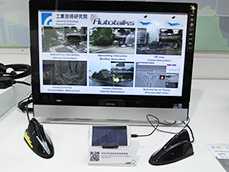 The exhibit for V2X using the DSRC system
The exhibit for V2X using the DSRC system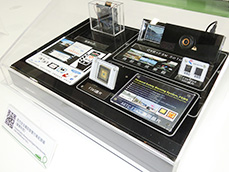 The exhibit for the smartphone application supporting the Collision avoidance system developed by TARC.
The exhibit for the smartphone application supporting the Collision avoidance system developed by TARC.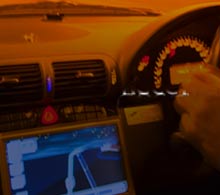 GPS/GNSS Receiver&Chips and Modules (positioning and timing)
GPS/GNSS Receiver&Chips and Modules (positioning and timing)